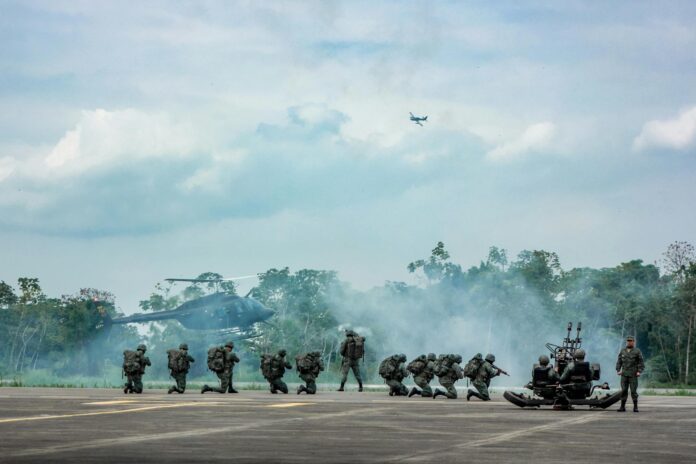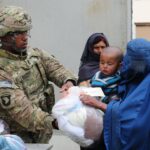[Uğur Orak]
Highlights
- Although military structures and enlistment characteristics have evolved over time, military service continues to be a profoundly transformative experience for individuals worldwide.
- Military service functions as a powerful agent of socialization for individuals, leading to the acquisition of new values, skill sets, and identities, which results in a range of behavioral and emotional consequences.
- Military service can have both positive and negative effects on individuals’ lives and behaviors, depending on their experiences and challenges during and after service.
- Recognizing the significance of military service in shaping individuals’ lives and behaviors is important and has far-reaching implications for the well-being of servicemembers, public safety, and national security.
Key Terms
- Social Institutions: Social groups or organizations that possess particular values, norms, and expectations, and operate to meet the social needs of individuals in a society.
- Resocialization: A learning and adaptation process through which an individual is introduced to new norms, values, and expectations that facilitate their transition from one social position to another.
- Turning Points: Particular life events or experiences that lead to significant changes in individuals’ life trajectories.
- Total Institution: A residential or workplace where a large number of similarly situated individuals, separated from the broader society for an extended period, collectively lead a structured and formally administered life.
- Social Roles: A set of actions and behaviors that individuals are typically expected to display as a result of their social status, responsibilities, and group affiliation.
- Posttraumatic Stress Disorder (PTSD): A mental health condition caused by experiencing or witnessing traumatic events and characterized by symptoms such as recurrent intrusive thoughts, avoidance behaviors, cognitive and mood changes, and changing arousal and reactivity.
Introduction
The evolution of military service throughout history reflects broader transformations in societal values, priorities, and beliefs. From compulsory service to all-volunteer-force (AVF) models, military service has undergone changes in response to shifting geopolitical circumstances and social trends. Regardless of these changes, however, military service has been a significant factor in molding the course of human history, affecting political, economic, and social developments on a worldwide scale. From ancient empires to contemporary nation-states, the institution of military service has remained a constant, shaping the destiny of nations.
Today, military service is one of the most influential social institutions in contemporary societies, having a profound impact on the lives and behaviors of individuals all over the world. As one of the largest employers and an essential element of national defense, it serves as a significant milestone in the lives of numerous individuals. In addition to fostering discipline and camaraderie, military service presents individuals with a diverse array of challenges and opportunities(1). From the demands of basic training to the intricacies of combat operations, it tests individuals’ resilience, adaptability, and resourcefulness. Furthermore, military service transcends national borders, bringing together a global community of service members united by a shared sense of purpose and mission(2).
The importance of military service extends beyond its immediate effects on individuals; it also shapes the fabric of communities and nations(3). Military institutions serve as symbols of national identity and pride, reflecting the collective aspirations and values of society. The commitment to defend one’s country and uphold its ideals resonates across generations, creating bonds of solidarity and loyalty that endure through times of peace and conflict.
This report provides an overview of the impact of military service on human behavior and life, drawing on major perspectives and findings from prior research in various fields, such as Sociology, Criminology, Psychology, Epidemiology, and Public Health. The first part of the report examines how military service functions as a process of resocialization in an individual’s life. Then, it focuses on potential impacts of military service on behavioral patterns and illustrates how military experience can alter an individual’s life path. It is important to recognize that military service can have a wide range of positive and negative effects on individuals’ lives. Although space constraints prevent a comprehensive discussion of all these effects, the examples provided offer a glimpse into the transformative nature of military service in contemporary society. The report concludes with a summary of the implications for policy, practice, and future research.
Military Service as a Resocialization Process
Military service often introduces individuals to a unique culture and set of standards, signifying a profound transition in their socialization process. Upon enlistment, individuals typically experience a substantial change in their identity, moving from civilian life to the structured framework of the military’s hierarchical system(4,5). Scholars have emphasized the resocialization process as a critical component of military service, during which existing values and norms are replaced by those of the military institution(6). This process not only involves the acquisition of fresh skills and knowledge but also the internalization of military values such as discipline, devotion, and selflessness. The resocialization process redefines individuals’ identities and life paths, positioning military service as a major turning point in their lives(7).
Additionally, the resocialization process extends beyond the acquisition of military skills and values and encompasses the formation of deep and enduring bonds among service members(8). The shared experiences of training, deployment, and combat foster strong interpersonal connections that persist beyond the military service. These bonds offer individuals emotional support and solidarity, imparting a sense of belonging and purpose in the face of adversity(9). The resocialization process thus leads to both individual transformation and collective cohesion, indicating the significant impact of military service on human social dynamics.
Previous studies have indicated that the military functions as a “total” and “greedy” institution, characterized by extensive demands and a strong emphasis on internal cohesion and social connections among soldiers(6,9). It exercises pressures on its members to weaken their connections with other institutions or people that may make conflicting claims on their loyalty(10). In order to maintain the undivided loyalty of its members, the military must establish symbolic boundaries between military and civilian life. This helps to prevent conflicting demands, social roles, and status positions, and fosters strong social bonds and cohesion within the military.
Military resocialization can equip individuals with valuable qualities and inspire positive changes in their lives, including the development of more structured routines, stronger social bonds, greater independence, and a broader range of perspectives and experiences(11-13). This process may prove transformative for service members in numerous positive ways. However, negative experiences during military service, exposure to traumatic incidents, and extended separation from the broader society can also pose significant challenges, particularly during the transition back into civilian life(14,15). The following section will provide examples of how these challenges can result in negative outcomes for military service members.
The Effects of Military Service on Human Life and Behaviors
Individuals who serve in the military are exposed to a wide range of stressors, including combat and the demands of military life, which can have serious consequences for their mental health16. Research indicates that compared to civilians, veterans are at higher risk of developing mental health disorders such as posttraumatic stress disorder (PTSD), depression, and anxiety(17,18). The impact of combat exposure on mental health is particularly significant, with military veterans experiencing long-lasting effects that continue beyond their military service(19,20). Furthermore, the impact of military service on mental health extends beyond individual experiences to encompass broader systemic factors and institutional practices. Within military culture, the stigmatization of mental illness and limited access to mental health resources and support create barriers to effective treatment and recovery(21). Additionally, the normalization of trauma and suffering as inherent aspects of military service can perpetuate cycles of psychological distress and emotional turmoil among veterans. Given the prevalence of mental health issues among veterans, it is crucial to provide comprehensive support services and interventions to help them overcome the challenges they face when transitioning to civilian life. To address the mental health needs of military personnel and veterans, a holistic approach is needed that addresses the underlying social, cultural, and structural determinants of mental illness and promotes resilience, healing, and community support.
In addition to mental health implications of military service, the relationship between military service and criminal behavior is also an important topic of scholarly investigation. While some research suggests that military service can serve as a positive turning point, enabling individuals to leave negative environments and avoid criminal activity(22,23), other studies indicate that it can also lead to the development of criminal behaviors such as drug use and violent crimes(24-26). The life course concept of turning points provides a framework for understanding the complex relationship between military service and crime. This framework posits that engagement with the military institution can either strengthen individuals’ ties to conventional society or disrupt their social bonds, depending on factors such as the nature of military experiences and individual predispositions(27,28).
Recent studies reveal that approximately one-third of former military service members in the U.S. have been arrested or jailed within the past year, a rate nearly twice that of their civilian counterparts(29-31). Although more research is needed to clarify the reasons behind this disparity, findings indicate that military service members are more likely than civilians to have experienced adverse childhood experiences (ACEs) and mental health issues such as posttraumatic stress disorder (PTSD), traumatic brain injury (TBI), and substance use disorders, all of which are also well-established risk factors for criminal behavior(32-36). Moreover, studies suggest that negative experiences faced by service members after leaving the military, including adaptation difficulties, family problems, unemployment, and homelessness, may further increase their likelihood of engaging in criminal activity(37,38).
Military service has a transformative impact on both individuals and societies, as exemplified by its effects on mental health and criminal behavior. It can also influence individuals’ lives and behaviors in a multitude of ways, some of which are positive while others are detrimental. Despite recent efforts to investigate military service’s relationship with several life outcomes, the field remains largely unexplored. This report underlines the importance of conducting further research on military service, as it may have significant implications for service members, public safety and wellbeing, and national security.
Implications
The findings and perspectives presented in this report have important implications for policy, practice, and research pertaining to military service and its repercussions on human life and behavior. First, they highlight the need to examine military service experience from a holistic perspective, including its potential positive and negative impacts on individuals’ lives. It is crucial for policies aimed at assisting service members, veterans, and their families to prioritize mental health screening, treatment, and support services to overcome the unique challenges they face. Programs and interventions that foster resilience, coping skills, and social support can improve the well-being and adjustment of military personnel throughout their service and the transition to civilian life. Additionally, research should investigate the intersections of military service with other variables, such as individual demographics and military occupational specialties, to provide a more comprehensive understanding of its effects on diverse populations.
Understanding the connections between military service members’ experiences and national security is crucial for shaping defense strategies, recruitment efforts, and force readiness. Recognizing the link between the well-being of service members and the security of the nation is essential for policymakers to develop policies and programs that enhance military effectiveness and readiness while safeguarding the welfare of those who serve. Military service holds a distinct position in human experience, including the ideals of responsibility and selflessness while also encompassing the intricate nature of institutional life. It is important to acknowledge the diverse range of experiences and perspectives of military personnel to gain a deeper understanding of the implications of military service on both individuals and society as a whole.
References
1. Orak, U., & Walker, M. H. (2021). Military service: A pathway to conformity or a school for deviance? Crime & Delinquency, 67(6–7), 1046–1069. https://doi.org/10.1177/0011128719850497
2. NATO Veterans Initiative. https://nato-veterans.org/about/
3. Shields, P. (2020). Dynamic Intersection of Military and Society. In A. Sookermany (Eds.), Handbook of Military Sciences. Springer. https://link.springer.com/referencework/10.1007/978-3-030-02866-4#toc
4. Hollingshead, A. B. (1946). Adjustment to Military Life. American Journal of Sociology, 51, 439-447. https://www.journals.uchicago.edu/doi/abs/10.1086/219855?journalCode=ajs
5. Sampson, R. J., & Laub, J. H. (2005). A life-course view of the development of crime. The ANNALS of the American Academy of Political and Social Science, 602(1), 12–45. https://doi.org/10.1177/0002716205280075
6. Segal, M. W. (1986). The Military and the Family as Greedy Institutions. Armed Forces & Society, 13, 9-38. https://doi.org/10.1177/0095327X8601300101
7. Laub, J. H. & Sampson, R. J. (2003). Shared Beginnings, Divergent Lives: Delinquent Boys to Age 70. Cambridge, MA: Harvard University Press.
8. Sampson, R. J. & Laub, J. H. (1993). Crime in the Making: Pathways and Turning Points through Life. Cambridge, MA: Harvard University Press.
9. Goffman, E. (1961). Asylums: Essays on the social situations of mental patients and other inmates. Oxford, England: Doubleday (Anchor).
10. Coser, L. A. (1974). Greedy Institutions. Patterns of Undivided Commitment. New York, NY: The Free Press.
11. Gloyd, E.L., Leal, W.E. (2018) “About Face” for delinquent youth: Military service as a turning point across the life course. Journal of Developmental and Life Course Criminology, 5, 461–479. https://doi.org/10.1007/s40865-018-0096-7
12. Teachman, J., & Tedrow, L. (2016). Altering the life course: Military service and contact with the criminal justice system. Social science research, 60, 74–87. https://doi.org/10.1016/j.ssresearch.2016.04.003
13. Orak, U., & Solakoglu, O. (2021). Strain and deviant reactions in compulsory military service: An investigation of mediating mechanisms. Crime & Delinquency, 69(4), 841–863. https://doi.org/10.1177/0011128721999337
14. Bray, R. M., Brown, J. M., & Williams, J. (2013). Trends in binge and heavy drinking, alcohol-related problems, and combat exposure in the US military. Substance Use & Misuse, 48(10), 799–810. https://doi.org/10.3109/10826084.2013.796990
15. Hoyt, T., Wray, A. M., & Rielage, J. K. (2014). Preliminary investigation of the roles of military background and posttraumatic stress symptoms in frequency and recidivism of intimate partner violence perpetration among court-referred men. Journal of Interpersonal Violence, 29(6), 1094–1110. https://doi.org/10.1177/0886260513506058
16. Katon, J. G., Lehavot, K., Simpson, T. L., Williams, E. C., Barnett, S. B., Grossbard, J. R., Schure, M. B., Gray, K. E., & Reiber, G. E. (2015). Adverse childhood experiences, military service, and adult health. American Journal of Preventive Medicine, 49(4), 573–582. https://doi.org/10.1016/j.amepre.2015.03.020
17. Orak, U., Kelton, K., Vaughn, M. G., Tsai, J., & Pietrzak, R. H. (2023). Homelessness and contact with the criminal legal system among U.S. combat veterans: An exploration of potential mediating factors. Criminal Justice and Behavior, 50(3), 392–409. https://doi.org/10.1177/00938548221140352
18. Orak, U., Yildiz, M., Aydogdu, R., Koenig, H. G., & Pietrzak, R. H. (2023). The relationship between combat exposure and suicide risk in U.S. military veterans: Exploring the role of posttraumatic stress symptoms and religious coping. Journal of affective disorders, 341, 77–87. https://doi.org/10.1016/j.jad.2023.08.115
19. Brooks, M. S., Laditka, S. B., & Laditka, J. N. (2008). Long-term effects of military service on mental health among veterans of the Vietnam War era. Military medicine, 173(6), 570–575. https://doi.org/10.7205/milmed.173.6.570
20. Sharif Nia, H., Ebadi, A., Lehto, R. H., & Peyrovi, H. (2015). The experience of death anxiety in Iranian war veterans: a phenomenology study. Death studies, 39(1-5), 281–287. https://doi.org/10.1080/07481187.2014.991956
21. Kline, A. C., Panza, K. E., Nichter, B., Tsai, J., Harpaz-Rotem, I., Norman, S. B., & Pietrzak, R. H. (2022). Mental health care use among U.S. military veterans: Results from the 2019-2020 national health and resilience in veterans study. Psychiatric Services, 73(6), 628–635. https://doi.org/10.1176/appi.ps.202100112
22. Browning, H. L., Lopreato, S. C., & Poston, D. L. (1973). Income and Veteran Status: Variations Among Mexican Americans, Blacks and Anglos. American Sociological Review, 38(1), 74–85. https://doi.org/10.2307/2094332
23. Elder, Glen H. 1999. Children of the Great Depression: Social Change in Life Experience. Boulder, CO: Westview Press.
24. Orak, U., Soileau, C., Harter, J., Dobson, C., & Huey Dye, M. (2023). Juvenile Violent Victimization and Adult Criminal Outcomes: The Role of Military Service as a Turning Point in Young Adulthood. Journal of interpersonal violence. https://doi.org/10.1177/08862605231211923
25. Bryant, C. D. (1979). Khaki-Collar Crime: Deviant Behavior in the Military Context. New York, NY: Free Press.
26. Snowden, D. L., Oh, S., Salas-Wright, C. P., Vaughn, M. G., & King, E. (2017). Military service and crime: new evidence. Social psychiatry and psychiatric epidemiology, 52(5), 605–615. https://doi.org/10.1007/s00127-017-1342-8
27. Elder, G. H. (1986). Military times and turning points in men’s lives. Developmental Psychology, 22(2), 233–245. https://doi.org/10.1037/0012-1649.22.2.233
28. Laub, J. H. & Sampson, R. J. (1993). Turning Points in the Life Course: Why Change Matters to the Study of Crime. Criminology, 31(3):301-325. https://doi.org/10.1111/j.1745-9125.1993.tb01132.x
29. Snowden, D. L., Oh, S., Salas-Wright, C. P., Vaughn, M. G., & King, E. (2017). Military service and crime: New evidence. Social Psychiatry & Psychiatric Epidemiology, 52(5), 605-615. http://doi.org/10.1007/s00127-017-1342-8
30. Timko, C., Nash, A., Owens, M. D., Taylor, E., & Finlay, A. K. (2020). Systematic review of criminal and legal involvement after substance use and mental health treatment among veterans: Building toward needed research. Substance Abuse: Research & Treatment, 14, 1-13. https://doi.org/10.1177/1178221819901281
31. Orak, U., Kelton, K., Vaughn, M. G., Tsai, J., & Pietrzak, R. H. (2023). Homelessness and Contact with the Criminal Legal System among U.S. Combat Veterans: An Exploration of Potential Mediating Factors. Criminal Justice & Behavior, 50(3), 392–409. https://doi.org/10.1177/00938548221140352
32. Blosnich, J. R., Dichter, M. E., Cerulli, C., Batten, S. V., & Bossarte, R. M. (2014). Disparities in adverse childhood experiences among individuals with a history of military service. JAMA Psychiatry, 71(9), 1041–1048. https://doi.org/10.1001/jamapsychiatry.2014.724
33. Edalati, H., Nicholls, T. L., Crocker, A. G., Roy, L., Somers, J. M., & Patterson, M. L. (2017). Adverse childhood experiences and the risk of criminal justice involvement and victimization among homeless adults with mental illness. Psychiatric Services, 68(12), 1288–1295. https://doi.org/10.1176/appi.ps.201600330
34. Blodgett, J. C., Avoundjian, T., Finlay, A. K., Rosenthal, J., Asch, S. M., Maisel, N. C., & Midboe, A. M. (2015). Prevalence of mental health disorders among justice-involved veterans. Epidemiologic Reviews, 37, 163–176. https://doi.org/10.1093/epirev/mxu003
35. Backhaus, A., Gholizadeh, S., Godfrey, K. M., Pittman, J., & Afari, N. (2016). The many wounds of war: The association of service-related and clinical characteristics with problems with the law in Iraq and Afghanistan veterans. International Journal of Law & Psychiatry, 49(Pt B), 205–213. https://doi.org/10.1016/j.ijlp.2016.10.007
36. Tsai, J. (2019). Homelessness among U.S. veterans: Critical perspectives. Oxford University Press.
37. Tsai, J., Rosenheck, R. A., Kasprow, W. J., & McGuire, J. F. (2014). Homelessness in a national sample of incarcerated veterans in state and federal prisons. Administration & Policy in Mental Health, 41(3), 360–367. https://doi.org/10.1007/s10488-013-0483-7
38. Markowitz, F. E., Kintzle, S., & Castro, C. A. (2023). Military-to-civilian transition strains and risky behavior among post-9/11 veterans. Military Psychology, 35(1), 38–49. https://doi.org/10.1080/08995605.2022.2065177
Ugur Orak, Ph.D., is a criminologist and Assistant Professor in the Department of Sociology and Anthropology at Middle Tennessee State University. His research interests include developmental and life-course criminology, mental health, and military sociology.



